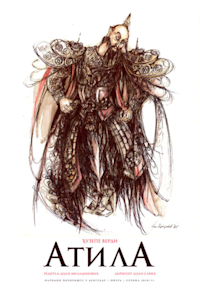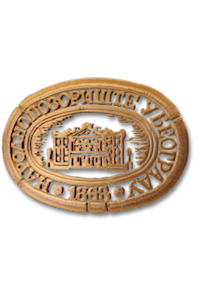Attila, king of the Huns, ruled from 434 to 453. The center of his state, which stretched from Denmark to Pannonia and from the Rhine to the Caspian Sea, was in the Hungarian lowlands, near the city of Tokaj. His supreme authority was recognized by many Germanic and Slavic tribes, and occasionally by Byzantium. In the year 451, he tried to conquer the western Roman Gaul, but was defeated by the military leader Ecija in the Catalan fields. The following year, he ravaged Italy, destroyed Aquileia, whose fleeing inhabitants founded Venice on the Adriatic lagoons, and set out to conquer Rome. He was met by Pope Leo I and Attila, according to legend, "converted", gave up on conquering and destroying the capital and returned to Hungary. This encounter was immortalized by Raphael in his famous painting. The German Romantic playwright Zacharias Werner (1786–1823) wrote the play Attila, King of the Huns in 1803., which bears all the hallmarks of unbridled and exaggerated romance. The content of the play deals with the famous historical campaign of the Huns in Rome in the middle of the 5th century, Attila's obedience to the divine command pronounced through the mouth of Pope Leo I, Attila's interference in the intrigues of the opponent and his murder by a woman with whom he was celebrating a wedding feast. From our, modern point of view, the plot is illogical, confusing and clumsy, so I don't even think about performing this work anymore. But isn't the same true for the plays of, according to many, the greatest French poet Victor Hugo ( Hernani, Rui Blaz, Lucrezia Borgia)? Werner's Attila contains, following the example of ancient tragedies, a large number of choirs that require music, ie opera singing. The fact that even Beethoven seriously considered writing an opera based on him speaks best about how much this play meant to contemporaries! Verdi, with the librettist Piave, after the great success with Hernani , is delighted with the content of Werner's Attilaand in great haste, he began work on his new opera in the spring of 1844. He asked the librettist "a piece in three acts with a prologue, so that the curtain rises at the moment when the Huns and the people in devastated Aquileia sing strong murderous choirs: the people pray and the Huns are threatening. " "The first act begins in Rome and ends with a scene in which Hildegonda warns that the drink in the cup was poisoned, and seeks the satisfaction of punishing the culprit with his own hands," Verdi continued in describing his wishes, fearing that censorship the pope and the "whip of God" Attila. Verdi begs the librettist to study well the writing of Mrs. De Stahl about Germany, who gave the whole of Europe a romantic vision of the nature of simple, honest, just and somewhat bloodthirsty peoples from the north. A large number of characters from the drama have been reduced in the libretto to a total of six, of which four are major and two are episodic. The Princess of Burgundy Hildegonda became the daughter of the Aquileian lord - Odabela, Walter became the knight of Foresto, and Bishop and Pope Leon appeared only in the scene of the meeting with Attila. Verdi and Pjava with the opera Two Foscarias (after Byron) celebrated success in Rome in November 1844, and in February 1845. Verdi and the librettist Themistocles Soler had success at the Scala in Milan with the opera Joan of Orleans (after Schiller). In August 1845, with Alizir, which the famous librettist Camarano concluded for Verdi after Voltaire's tragedy, success is completely absent and Verdi decides to change the librettist for Attila , because success is just what he needs. Solera was given the task of arranging everything, and Verdi was delighted with the parts of the libretto that he quickly composed. The premiere is scheduled for the opera La Fenice in Venice, and the best singers have been chosen. The title role will be sung by bass Ignacio Marini, who sang the title role in Verdi's first opera Oberto ; the tenor role of the famous singer Carlo Gvasco, the only female role of the even more famous Sofia Leve, and the baritone role of the military leader Ecija, the "old rabbit", Natale Constantini. But also with Attilanot everything went according to plan: when Solera's wife Teresa, a famous singer, was ridiculed in Scala, the offended Solera left Milan and went to Madrid, as a close associate and advisor to Queen Isabella of Spain, before finishing the last act of Attila 's libretto. the job is again entrusted to the rejected Piave. Solera was mortally offended when he read a new cover of "works he was not a little proud of, and which turned into a parody", but in the opera world such things are not taken too seriously. And so the libretto for Attilait is neither better nor worse than every libretto from that time, so we accept many inconsistencies, not to mention omissions in the libretto, as normal. The libretto is not even intended for reading, as a drama, but as an occasion for composing beautiful and effective arias, romances and cabaret, grand finale with choirs, and every listener knew where the opera got which singer got a certain aria or duet. At the time of the national revival of Italy, during the years of struggle for unification and liberation, the audience in all opera houses in Italy was anxiously waiting to react spontaneously to some verses from the libretto. In Attila, the invitation of Ecija Attila: "You rule the whole world, leave me to rule Italy alone", the audience accepts and understands it as a call to expel the Austrian occupiers and that guarantees the opera unprecedented success. At the premiere, March 17, 1846, the success was complete and after a short time Attila was shown on all stages of Italy, and the following year in Copenhagen, Madrid and Lisbon. Then London, Havana, New York, Bucharest. In 1851 Vienna, 1852 Budapest, 1853 Buenos Aires, Rio de Janeiro and the rest of the opera world, so that in 1864 a commentator concluded: "Probably no other opera by Verdi has had as much success as Attila.! ”However, with the appearance of operas from the more mature Verdi period, this opera by the young master is being performed less and less, and soon it completely disappears from the opera stages. It was only in the years after the Second World War that Attila 's cautious and almost timid "renaissance" began , in order to experience real triumphs in the last few years. In 1985, the hit of the season was in the Verona Arena, shown in Vienna, Sofia, Zurich, Venice, Naples and other cities, and it is optimistic that Attila will join Nabucco, which is also "in fashion" again in recent decades. “. Strong rhythms, firmer, more lively, deadly choirs than those in Nabucco, thankful arias, effective duets and large mass scenes with many movements, as well as numerous melodies that are easy to receive, mastery in the craft aspect - these are the qualities that can attract the widest audience, interested in a great historical spectacle and beautiful voices. Attila begins with an overture, which is not a mix of popular melodies from the opera, but a dark introduction to the work, based on a motif that druids will sing predicting misfortune. The prologue contains warrior choirs followed by Odabelina cavatina ( While your wild warriors), a challenging Amazon aria, hard and difficult, but successful and effective. Kabaleta with the choir is a new opportunity for the soprano to perform. Attila's duet with Ezio is a real bass singing with baritone, and it's a real challenge for the singers. Introductory music other pictures of the prologue tonal picture of a terrible storm on the lagoon. Forest 's Cavatina and Cabalet ( Dear Country)giving Verdi the opportunity for the greatest possible musical contrast in general. The famous sentence of the old man Leone (Pope Leo I) "Mortals flee before you, they are afraid of your scourge. Now stop! You can't go on, because God rules here ", sung in a stentor's voice, hints at a future scene with the Grand Inquisitor fromDon Carlos . At the end of the first act, the powerful ensemble of gratitude testifies enough to the mastery of young Verdi. The aria Ecija at the beginning of the second act is a real pearl for baritones and is gladly sung. The loud march in the finale of this act is hardly unmatched in the operas of that time. The play of the priestesses and their wavy song provide the necessary contrast and rest. A large ensemble with extremes in dynamics is looking for a great choir. The finale is noisy, effective, thankful and tiring for all the soloists. Romance Forest ( For you, I lived) in the third act, according to many commentators, represents the most beautiful part of the whole opera and is certainly one of the most grateful arias of the young Verdi. The trio of sopranos, tenors and baritones is a lyrical oasis, and the mastery of the author in mixing the wedding choir with the recitatives of the soloists is indisputable. The final finale is too concise; Attila's murder is musically inexpressive, so that many directors, in cooperation with the conductors of the play, even inserted excerpts from some other operas by young Verdi into this scene, so that the ending would be more convincing and longer. It seems to us that this is not necessary after all. In continuing the intention to show our audience as many operas by the great Giuseppe Verdi as possible, after Hernani and Macbeth , Attila is just imposing himself, because we have an ensemble that can inform him appropriately.





